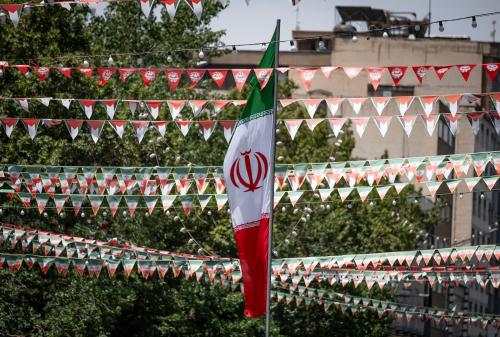As the saying goes, while politicians and civilians like to think about strategy when contemplating war, generals think logistics. If the United States and any coalition partners go to war against Iraq, the first part of that logistics effort requires getting up to a quarter- million combat troops from the United States to the Persian Gulf.
Without prejudging the desirability of waging a war to unseat Saddam, how long would it take to get ready for one, and how would it be done?
The answer, in rough terms, is that it would probably take the United States three months to position 250,000 troops in the vicinity of Iraq. As a matter of prudence, therefore, the Bush administration probably needs to make its final decision on war by November, if it is considering overthrowing Saddam this winter.
Consider the following simplified timeline for a deployment of combat forces to the Gulf, which would necessitate the movement of perhaps 10 wings of land-based fighter aircraft, 30 to 50 ships, including three to five aircraft carriers, and four to five divisions of ground forces:
* Day 1: Initial U.S. capabilities would consist of the 30,000 American troops already in place. Today’s U.S. presence in the vicinity of Iraq includes, roughly speaking, 5,000 troops in Kuwait, about 5,000 in Saudi Arabia, about 2,000 in Bahrain, about 2,000 in Turkey, another 2,000 around the region in places such as Oman, and anywhere from 10,000 to 15,000 on ships in the Persian Gulf itself. In broad terms, this total presence amounts to a brigade of ground forces (three brigades go into the typical division), two to three wings of land-based combat aircraft (each with about 70 jets), and one aircraft carrier (also with 70 to 80 planes aboard).
*Day 15: By this point, about 50,000 more troops might arrive, if everything goes smoothly. Simplifying somewhat, the additional personnel would be in two general categories.
The first would be additional land-based airpower. Additional forces might total two to three more fighter wings and their needed supplies such as munitions, spare parts, and maintenance equipment. The aircraft would “self-deploy,” though they would need help from refueling airplanes en route, and would also need transport aircraft to carry support equipment and ordnance.
The second category of additional forces would be more ground power. Most notably, within this time frame, troops could fly from the United States to “marry up” with extra equipment already stored in and about the Persian Gulf. That could include up to five more brigades (each consisting of about 3,000 to 5,000 troops); one Army brigade set of equipment on land in Kuwait, one Army set on land in Qatar, one Army set afloat at Diego Garcia in the Indian Ocean, and two Marine sets, one also at Diego Garcia, the other in the Mediterranean.
In addition, some light forces, such as parts of the 82nd Airborne division or 10th Mountain division, could be flown into the region. However, it is not clear that commanders would consider their deployment urgent enough to justify devoting scarce airlift capacity to them at this stage. (Airlift would also be needed to deploy assets such as attack helicopters, missile defense systems, and communications gear.) Marine forces in East Asia could also arrive during this time frame, though U.S. officials and allies might prefer not to take them out of that region.
* Day 30: By the end of the first month, another 25,000 troops might arrive, mostly in the form of additional airpower and additional Navy forces. Virtually any U.S. Navy ship that had been at sea, anywhere in the world, when the deployment decision was made could probably arrive in the Gulf within this time frame. Most of the Air Force deployment could be concluded in this time frame if needed as well.
* Day 60: Close to another 100,000 troops could arrive by this point, bringing the grand total to about 200,000. The main contribution would come from heavy forces stationed in the United States. The first to arrive would be Marines who could quickly board amphibious shipping and Army forces able to make use of fast sealift ships with “roll-on/roll-off” easy loading capabilities. The United States has enough capacity to deploy about three divisions in this way—one with Marine Corps amphibious shipping, one with its SL-7s that performed so well before the 1991 Gulf War, and one with its new “LMSRs” acquired during the Clinton administration.
In theory, all of these forces could arrive in theater by day 60, allowing for time to move the equipment to U.S. ports, load it, ship it across the ocean, and unload it. In practice, bottlenecks in a place such as Kuwait, with its limited deep-water port capacity, could slow down the operation.
* Day 90: Completion of the deployment, bringing it to about 250,000 troops. Slower ships could deploy additional ground forces, most notably support equipment for the combat divisions that had already arrived, as well as additional fuel, ammunition, and so forth. “Traffic jams” at ports in Kuwait and any other deployment destinations could be cleared up. By roughly this point, the United States would be fully ready for war.
But February is only five months away. It is not clear we have a realistic option of going to war this winter, unless we get our diplomatic strategy in place quickly in the coming weeks.
The Brookings Institution is committed to quality, independence, and impact.
We are supported by a diverse array of funders. In line with our values and policies, each Brookings publication represents the sole views of its author(s).



Commentary
Op-edThree Months to Baghdad
August 30, 2002